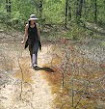BTW: One gem I learned from Steve that day: when you're trying to restore our mixedwood forests (remember: we used to have an overstorey of red and white pine here, above our deciduous canopy species - and if you look at the horizon, you still see a few remnant examples of this in the Credit and the Rouge), plant the conifers together with shrubs (ie: not right up against near new or existing deciduous trees) because the deciduous/hardwoods will out shade them too fast. So smart it seemed dead obvious once he told me, but I had never seen, read or realized it myself. That's some cool stuff Steve. Thank you!
29 April 2009
Goulding Estate with Steve Smith
Goulding Estate, Taylor Massey Creek
Along with volunteers from FODE and Ontario Nature I recently had a chance to work alongside Steve Smith at a recent tree and shrub planting at Goulding Estate in Taylor Massey Creek, an east lower Don tributary here in Toronto. That day was a lot of cool riparian woody and his smart range of plants and super-specific site selections really took me to school. I especially appreciated the bitternut hickory, red oak (there are existing remnants on the uplands), butternuts (keep planting those nuts), yellow birch - oh and maybe twenty more species. Blew my mind really, and reshuffled my deck: I don't know about you, but I tend to see or accidentally fall into patterns / ruts / limited repetoires of the same species. Even better? Steve's been involved with the plants on this site for 20 years. Exactly the kind of eyes you want to see the place through. Reminded me of a quote from Lily Tomlin: "If Tom Waits ever invites you to get drunk at his trailer in the desert for a week - do it!" What I mean is, volunteering out in the field and being with folks who know a place and have applied more than a few of their skills there, will teach you things you just will not learn in school (especially when some of the folks you want to learn from right now are too busy out in the field to write or teach). So get out there (or take your chances waiting for them to retire and hopefully have the health and the desire to write a book or teach a course). See the list of "Volunteer" links lower down in the right sidebar, and check out our local Event Calendars.
BTW: One gem I learned from Steve that day: when you're trying to restore our mixedwood forests (remember: we used to have an overstorey of red and white pine here, above our deciduous canopy species - and if you look at the horizon, you still see a few remnant examples of this in the Credit and the Rouge), plant the conifers together with shrubs (ie: not right up against near new or existing deciduous trees) because the deciduous/hardwoods will out shade them too fast. So smart it seemed dead obvious once he told me, but I had never seen, read or realized it myself. That's some cool stuff Steve. Thank you!
BTW: One gem I learned from Steve that day: when you're trying to restore our mixedwood forests (remember: we used to have an overstorey of red and white pine here, above our deciduous canopy species - and if you look at the horizon, you still see a few remnant examples of this in the Credit and the Rouge), plant the conifers together with shrubs (ie: not right up against near new or existing deciduous trees) because the deciduous/hardwoods will out shade them too fast. So smart it seemed dead obvious once he told me, but I had never seen, read or realized it myself. That's some cool stuff Steve. Thank you!
Subscribe to:
Post Comments (Atom)


1 comment:
You're welcome. You're pretty good too. ;)
Post a Comment